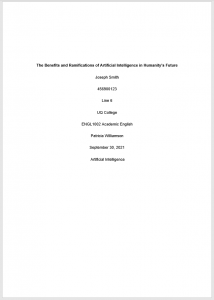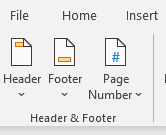27 Writing and Formatting a Discursive Essay
The previous chapter describes a discursive essay as a form of critical essay that attempts to provide the reader with a balanced argument on a topic, supported by evidence. This chapter examines the structure in increased depth.
Organise your key claims and counter-claims
Consider how you want your reader to move through your arguments for and against your controlling ideas. When you write your essay outline sentence in the introduction, the controlling ideas should appear in the same order as they will be organised within the essay body. For example, in an essay about artificial intelligence, if the essay outline sentence states “This essay will argue how the influence of AI may impact the health, military, and industrial sectors of society and whether the benefits outweigh the negative ramifications on humanity’s future”, then the body paragraphs must follow the same sequence – health, military, and industrial sectors.
For each of these controlling ideas, there must be both a supportable claim and counter claim. As the outline sentence states, the essay will discuss “whether the benefits outweigh the negative ramifications on humanity’s future.” Therefore, both sides of the argument must be presented, both perspectives, in a nonbiased manner.
Outline
As you begin to write your essay outline, include your supportable claims and counter claims in the body paragraphs. Go as far as to note sources that may be used as supporting evidence. Do not forget to synthesize your academic sources. Synthesizing simply means combining. Instead of summarising main points from each text in turn, you combine the key ideas and findings of multiple sources to make an overall point. At its most basic level it involves looking at the similarities and differences between all your sources (this is examined in week 16 of TPP Academic English).
Example Body Paragraph Outline
Note the focus here is on the non-bracketed sections of the paragraph.
Topic sentence and controlling idea: Artificial Intelligence [AI] (topic) within the medical industry (controlling idea – health) is still in the early stages of conception.
Claim: Application of AI in the health sector poses concerns (claim) regarding the use of this technology – Sources: Finlayson et al. (2018); Yanisky-Ravid & Hallisey (2019)
(Elaboration – more information about the claim)
(Evidence -academic research)
Counter claim: Despite these factors (indicates a contrasting idea), the application of AI within the health sector, when used ethically, has (counter claim) the potential to revolutionize the future of health care – Sources: Topol (2019); Wahl et al. (2018)
(Elaboration – more information about the claim)
(Evidence -academic research)
Linking sentence: While application of AI within the health sector is significant to the future of humanity, so too is the impact of AI within the military.
NOTE: The topic and (singular) controlling idea are maintained throughout the paragraph. The linking sentence links AI to the next controlling idea – military use.
Once you have outlined your entire essay, including where you will use your academic sources, you are ready to write a draft discursive essay and flesh out your ideas. Remember that your reader has not done the same level of reading as you have on your chosen topic and be sure to walk them through your arguments step-by-step. Do not assume they understand the subtle connections between your assertions, evidence, and conclusions – make them obvious. Use good, clear signposting (see Chapter 20) and introduce your sources using reporting verbs (see Chapter 14). Remember good, clear, academic paragraph structure also (see Chapter 22).
Adhere to the Template and Formatting
Once at university you will not have your hand held through essay writing. There will most likely not be any time allocated in class to write or research. It is also unlikely that you will be provided with a template for assignment writing. Therefore, take every opportunity to learn the expected structures and formatting while preparing for future academic writing. It is your responsibility as a student to seek clarification from your teacher if there is something you do not understand.
While universities should provide model essays or assignments for students, often the instructions rely on prerequisite knowledge or assumed understanding of academic writing. Do not be afraid to ask questions. It is highly likely that other students in your class have similar questions and lack the initiative to come forward. Remember teachers/ tutors/ lecturers are there to teach and often they are a vastly untapped resource. Make an appointment or try to catch your teacher before or after class if it’s a quick question.
Formatting in APA 7th ed.
What many people do not know is that assignment formatting is aligned to the referencing style. Therefore, an assignment in MLA or Chicago style referencing will have different formatting to APA 7th ed. This is a question that needs to be answered by your lecturer, though below is a basic guide for formatting according to APA 7th edition and UQ College guidelines.
Font:
APA does not specify a single font or set of fonts however it is recommended you use sans serif fonts such as 11-point Calibri, 11-point Arial (university assignments).
Title Page:
APA 7 instructions for formatting the title pages of student papers (high school, college, or university courses). The following should be double line-spaced and centered vertically, that is, it should sit in the middle of the title page. However, the title page information should be centered in the upper half of the page.
Spacing:
The entire paper should be double line-spaced, including the title page, abstract, and reference list.
Title page information: DO NOT include sub-headings on the title page and follow the order as set out.
Title of the Paper (a mix of upper and lowercase; any word four letters or more should begin with a capital. It should be written in bold font and not contain abbreviations)
Author’s Name (that’s you)
Student ID (All assessments should include your eight / 8 digit student identification number, found on your ID card)
Class ID (every tutorial class has an allocated class line or number, please include this also)
Institutional Affiliation (UQ College)
Course number and name (ENGL1002 Academic English)
Instructor name (Do not include titles such as Dr. or Prof.)
Assignment due date (Written in full – September 30, 2021)
Assignment Topic (state the selected assignment topic)
Sample:

Header and Footer
APA does not use anything in the footer, however the paper does need a header with a page number and a copy of your thesis statement.
On the title page you will have the phrase Running Header: (no quotation marks and followed by a semi-colon before your thesis statement. The thesis statement begins with a capital letter) followed by your title or, in the case of your discursive essay, the thesis statement. Technically, the running header should be no more than 50 characters, including letters, spaces, and punctuation. Though in the case of the discursive essay, it is more important to your instructor / grader to have the thesis statement available to refer to on each page.
In the header and footer tab (click “Insert”, “edit header”) you can make the header on the first page different to the rest of the paper by checking the box that says “Different First Page.” In all headers that follow, you will not need the Running Header title, only the thesis statement. You can also decrease the Header margin from the top and use a smaller, less obtrusive, font – no smaller than 10 point font.
Example:
Running Header: The application of artificial intelligence is worrying to humanity and should be avoided, however there is a consensus that artificial intelligence promotes a promising future for humanity.
All following headers would only contain the thesis statement without the “Running Header” title.

You must also number each page, including the title page. In the header, tab to the far right, click the arrow on “Page Number” on the far left, then “Current Position” and finally, “Plain Number”. This will give you running page numbers, beginning on the title page. The number must appear in the top right-hand corner of the paper and must not include the word page or any abbreviation such as p., page 1 of.

Please note, these instructions are for Microsoft Word and your personal device may vary.
If you have questions regarding any aspect of your assignment, please do not hesitate to ask your teacher for assistance.
Showing no prejudice for or against something; impartial.

